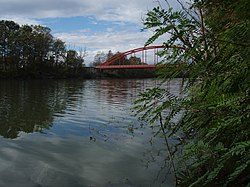The Spačva basin (Serbo-Croatian: Spačvanski bazen, Спачвански базен) is a geographic microregion in eastern Croatia and northwest Serbia. The region is located in the southwestern part of Syrmia—the latter being divided by Croatia and Serbia—and the southeastern part of Slavonia macroregion of Croatia, surrounding the Spačva River and the Studva River. The entire region measures 51,000 hectares, out of which 40,000 hectares is located in Croatia and 11,000 in Serbia.[1]
Spačva basin
| |
|---|---|
geographic region | |
 | |
 Spačva (region) together with Bosutska šuma | |
 | |
| Country | |
| Region | Syrmia |
| Administrative region | |
| Municipality | Otok, Nijemci, Privlaka, Šid |
| Time zone | UTC+1 (CET) |
| • Summer (DST) | UTC+2 (CEST) |

The region's 40,000 hectares of oak (Quercus robur) forests makes the Spačva basin one of the largest continuous lowland oak forests in Europe.[2][3][4] Up until the 1935 regulation of the bank of the Sava River the entire region was regularly flooded in spring.[1]
In addition, the region forms an organic continuum with the Bosut Forest (Bosutska šuma, Serbian Cyrillic: Босутска шума) in Vojvodina in Serbia. The Bosut Forest is one of two strict nature reserves in Vojvodina.[5] The Spačva basin and Bosut Forest form the northern section of forest and swampland complex spreading south of the Sava River as well, where it is known as Donje Podrinje in Bosnia and Herzegovina and Central Serbia.[6]
Wood industry based in Spačva basin is an important natural resource in the economic output of Vukovar-Syrmia County. The industrial exploitation of the forest was initiated in the 19th century at the time of Slavonian Military Frontier.[1] The major settlement in the region is the town of Otok.[3]
Gallery
edit-
Croatia
-
Serbia
-
Otočki virovi
See also
edit- Geography of Croatia
- Kopački Rit
- Historical Palača Swamp of the Bobota Canal
- Lonjsko Polje and Jelas-polje
- Gornje Podunavlje and Tikvara in Vojvodina
- Danube–Tisza Interfluve and Danube-Drava National Park in Hungary
- Ramsar Convention
- Vukovar Plateau
References
edit- ^ a b c Peleš, Petra (2020). Vretenca Spačvanskog bazena [Dragonflies of the Spačva Basin] (in Croatian). Vinkovci, Croatia: Public Institution for the Management of Protected Natural Values in the Vukovar-Syrmia County. ISBN 978-953-58754-6-8.
- ^ "Approved 10 projects over HRK million worth". 27 April 2016. Retrieved 2 December 2016.
- ^ a b Ika Lucić (2014). "The Impact of Spačvanski Bazen of Economic Development in Vukovar-Srijem County". Faculty of Science, University of Zagreb. Retrieved 2 December 2016.
- ^ Vuletić, Dijana. "Ecological and climate changes and regeneration related issues of pedunculate oak forests in Spačva basin". Croatian Forest Research Institute. Retrieved 25 February 2020.
- ^ "Bosutske šume – najveće lužnjačke šume u Evropi". Radio Television of Vojvodina. 7 May 2018. Retrieved 25 February 2020.
- ^ Jeremić, Jasna. "The area of Morovićko-bosutske šume and Spačvanski bazen as a potential retention and transboundary protected area". Retrieved 25 February 2020.